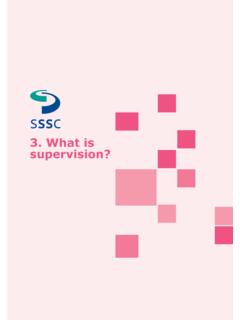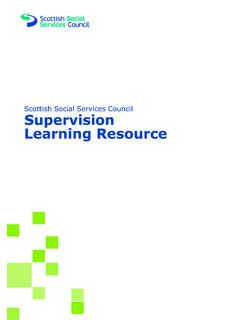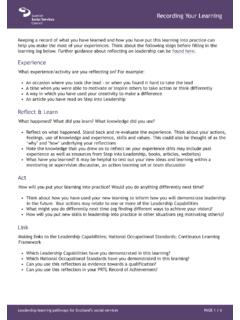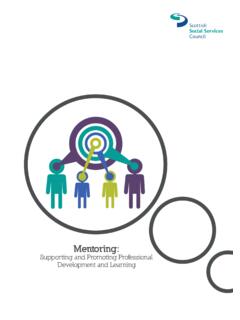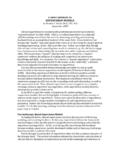Transcription of Group Supervision - Step Into Leadership
1 Group SupervisionPAGE 1 | 2 Leadership learning pathways for Scotland s social servicesWhat is Group Supervision ? Group Supervision is facilitator-led via a formal, prearranged process that is agreed by the supervisor and supervisees. The makeup of the Group depends on the goals of the Supervision . Group Supervision is a com-plement to, rather than substitute for, one-to- one Supervision , though it may reduce the frequency with which one-to-one Supervision is are the main goals of Group Supervision ? Group Supervision involves the use of a Group setting to enable members to reflect on their work. By pooling skills , experience and knowledge, the aim of the session is to improve the skills and capability of both individuals and the Group . The goal of the session may be to solve problems, plan work and set priorities, learn from others or make supervisor should discuss with the Group , and agree, how the agenda and focus of Supervision sessions will be centred on individuals who use services and their carers - ultimately, effective Group Supervision should result in better outcomes for This is the important distinction between Group Supervision and team meetings or other Group sessions Group Supervision is always centred on developing people with a specific focus on achieving better are the main benefits of effective Group Supervision ?
2 Effective Group Supervision can result in faster, more effective problem solving by drawing on the expertise of a Group of people. It allows for learning from the diverse backgrounds and experiences of different social services workers and practitioners, who may provide different perspectives on situations. Group Supervision presents an opportunity to address the concerns and issues of individuals and also an opportunity to develop in a Group setting: can give supervisees an increased sense of support by realising others have similar concerns allows supervisees to find new and better ways of dealing with their own situations by listening to others can allow supervisees to explore different ideas about how they will solve problems by obtaining a range of feedback from others about issues or concerns provides a safe environment where individuals can discuss their limitations and problems without criticism some individuals may find that they are more confident about opening up in a Group situation than in a one-to-one for running a successful Group Supervision session Have a clear agenda and clarify with the Group the purpose of the session what it is for, and equally what it is not for Make sure everyone is clear about their roles and responsibilities during the session.
3 Including confi- dentiality in the Group Establish some ground rules, and ensure everyone commits to them Set a time for the session in a quiet and comfortable environment where people are likely to feel at ease about opening up and sharing Adopt good facilitation methodology, and allow others to take the facilitation lead as they develop their skills Always record and share the decisions or actions that are agreed in the session (where appropriate update individuals notes and support plans also) Periodically reflect on methodology. Explore what works well and not so well with a view to improving the longer terms benefits can be achieved with a good approach to Group Supervision ? Increased job satisfaction Improved team communication Lower stress levels and better ability to cope in challenging circumstances Reduced self-doubt about ability to act in practice Increased self-awareness and sense of professional identity leading to reduced anxiety More positive relationships with people who use are the roles and responsibilities of the facilitator and the participants?
4 The effectiveness of Group Supervision depends on the facilitation skills of the person leading the Group , and the openness of the supervisees to share and reflect. The role of the facilitator is to guide the Group towards openly sharing ideas, opinions, expertise and expe-rience with a view to achieving an agreed set of goals, and then to gain commitment to follow-up facilitators plan in advance take a neutral position and focus purely on the Group process and desired outcomes listen actively and ask questions that encourage and direct participation relevant to the goals of the Group draw out quieter members of the Group and allow everyone a chance to participate are not afraid of silence they recognise when the Group needs space to think check for mutual understanding keep the Group focused on the agendaSupervisees (and indeed the facilitator)
5 Should be prepared to listen actively and share openly avoid taking the conversation off in directions that are not useful show respect towards others avoid dominating the discussion be mindful of their duties regarding confidentialityWhat is Group Supervision ? Group Supervision is facilitator-led via a formal, prearranged process that is agreed by the supervisor and supervisees. The makeup of the Group depends on the goals of the Supervision . Group Supervision is a com-plement to, rather than substitute for, one-to- one Supervision , though it may reduce the frequency with which one-to-one Supervision is are the main goals of Group Supervision ? Group Supervision involves the use of a Group setting to enable members to reflect on their work. By pooling skills , experience and knowledge, the aim of the session is to improve the skills and capability of both individuals and the Group .
6 The goal of the session may be to solve problems, plan work and set priorities, learn from others or make supervisor should discuss with the Group , and agree, how the agenda and focus of Supervision sessions will be centred on individuals who use services and their carers - ultimately, effective Group Supervision should result in better outcomes for This is the important distinction between Group Supervision and team meetings or other Group sessions Group Supervision is always centred on developing people with a specific focus on achieving better are the main benefits of effective Group Supervision ?Effective Group Supervision can result in faster, more effective problem solving by drawing on the expertise of a Group of people. It allows for learning from the diverse backgrounds and experiences of different social services workers and practitioners, who may provide different perspectives on situations.
7 Group Supervision presents an opportunity to address the concerns and issues of individuals and also an opportunity to develop in a Group setting: can give supervisees an increased sense of support by realising others have similar concerns allows supervisees to find new and better ways of dealing with their own situations by listening to others can allow supervisees to explore different ideas about how they will solve problems by obtaining a range of feedback from others about issues or concerns provides a safe environment were individuals can discuss their limitations and problems without criticism some individuals may find that they are more confident about opening up in a Group situation than in a one-to-one for running a successful Group Supervision session Have a clear agenda and clarify with the Group the purpose of the session what it is for, and equally what it is not for Make sure everyone is clear about their roles and responsibilities during the session.
8 Including confi dentiality in the Group Establish some ground rules, and ensure everyone commits to them Set a time for the session in a quiet and comfortable environment where people are likely to feel at ease about opening up and sharing Adopt good facilitation methodology, and allow others to take the facilitation lead as they develop their skills Always record and share the decisions or actions that are agreed in the session (where appropriate Group SupervisionPAGE 2 | 2 Leadership learning pathways for Scotland s social services update individuals notes and support plans also) Periodically reflect on methodology. Explore what works well and not so well with a view to improving the longer terms benefits can be achieved with a good approach to Group Supervision ? Increased job satisfaction Improved team communication Lower stress levels and better ability to cope in challenging circumstances Reduced self-doubt about ability to act in practice Increased self-awareness and sense of professional identity leading to reduced anxiety More positive relationships with people who use are the roles and responsibilities of the facilitator and the participants?
9 The effectiveness of Group Supervision depends on the facilitation skills of the person leading the Group , and the openness of the supervisees to share and reflect. The role of the facilitator is to guide the Group towards openly sharing ideas, opinions, expertise and expe-rience with a view to achieving an agreed set of goals, and then to gain commitment to follow-up facilitators: plan in advance take a neutral position and focus purely on the Group process and desired outcomes listen actively and ask questions that encourage and direct participation relevant to the goals of the Group draw out quieter members of the Group and allow everyone a chance to participate are not afraid of silence they recognise when the Group needs space to think check for mutual understanding keep the Group focused on the (and indeed the facilitator) should: be prepared to listen actively and share openly avoid taking the conversation off in directions that are not useful show respect towards others avoid dominating the discussion be mindful of their duties regarding confidentiality.
